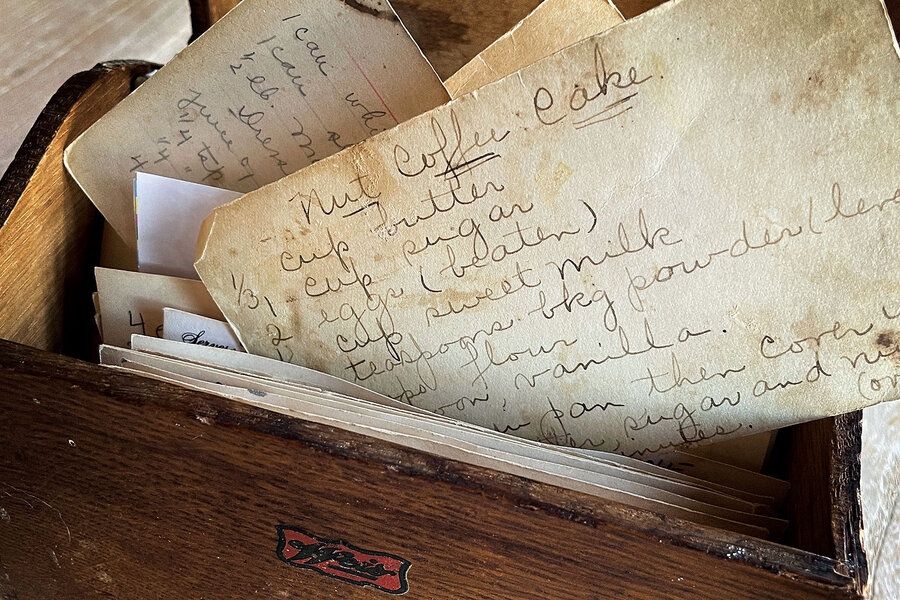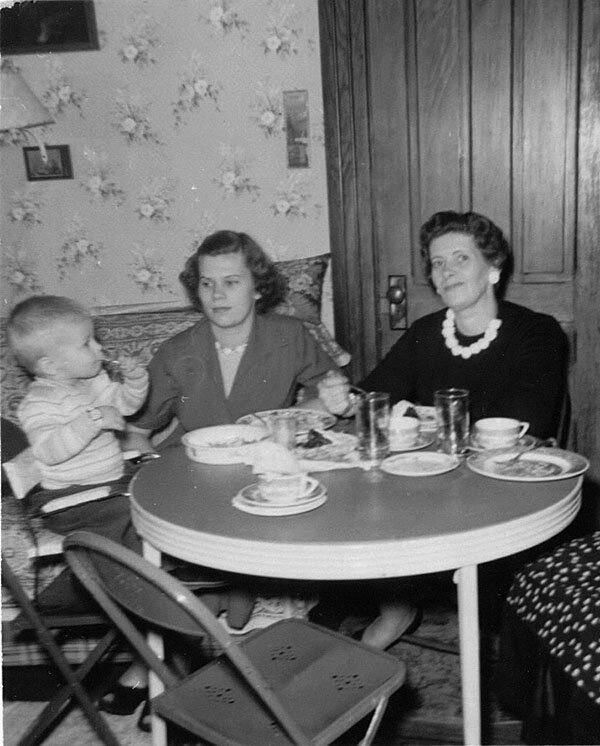Back of the box recipes from Great-Grandma? Family treasure.
Loading...
The mother of one of my son’s friends is taking a chocolate chip cookie from my open Tupperware, and I’m backpedaling.
“It’s from the back of the bag,” I say.
“It’s been in our family for generations,” my son says at the same time.
The woman looks confused, so I put my hand on his strawberry-blond hair. “We don’t have any family recipes, remember?”
He gives a dejected nod, and she takes a bite.
At age 9, my son is as fascinated by history as he is unencumbered by its facts. The more he wants something to be true, the more forcefully he will report it. This morning he insisted megalodons and velociraptors were brawling on prehistoric beaches, and this afternoon he tried to sell the Toll House cookie as a piece of family lore.
He craves heirlooms, provenance. If only there was a piece of antique furniture from a great-aunt, a Civil War saber from a distant cousin. If only there was treasure. There is a set of floral china, pieced together by my grandma from mid-’90s estate sales, but that’s not quite the legacy he yearns for. To his old soul, we’re mostly a profound disappointment: a family that doesn’t keep things.
He’s placed his remaining hopes in my recipe collection. If he can’t have an ancestral chest of gold buried in a hillside, he’d settle for a secret combination of herbs and spices.
And I don’t know what to tell him.
We’re white Midwesterners as far as genealogy websites can see. A nondescript mishmash of Western Europe and Appalachia that might lean a bit toward Ireland. But that doesn’t help much from a culinary perspective. My grandmothers had four and six children, respectively, and husbands who worked more than they parented and parented more than they cooked. Their culinary aesthetic was efficiency. And starch. Lots and lots of starch.
The closest thing I can offer my son is a black mini binder I keep stashed above the refrigerator. My great-grandmother, Rosemary, then in her 80s, gave it to me for my 11th birthday. It is filled with recipes, handwritten on half-sized lined paper, organized into blunt categories like “Meat,” “Dessert,” and, more vaguely, “Helps.” It is not, however, filled with family recipes.
Despite its rustic construction, the book isn’t the product of our ancestors’ creative labors in frontier kitchens or cozy Irish cottages. Mostly, it’s the product of Campbell’s soup, mixed with a few 20-minute dinners copied from the back of Bisquick boxes.
“This is a family recipe, right?” my son asked over and over when we flipped through the pages. “This one? This has to be at least a hundred years old, right?”
I had to break it to him that if a dish calls for lime Jell-O and mini marshmallows, it probably didn’t come from the old country.
I get it. I, too, was disappointed to see so little pedigree in those pages as a kid. Like my son, I wanted the gravitas of generations-deep traditions, something to distinguish us from all the other Indiana families I knew.
Instead, I got a lot of ideas for impossible pies.
In fairness, our family does have something approaching a legacy dish. Every Thanksgiving, we confound married-in members with a cold, clumpy delicacy called persimmon pudding.
My great-grandparents’ house – which later became my parents’ house – had a persimmon tree. No doubt Rosemary was gathering its fruits during the Great Depression, and it was still dropping persimmons when I left for college. If any recipe could lend some provenance to my little black binder, it would certainly be the one for persimmon pudding.
Except that recipe is not in the binder. Every November, I make persimmon pudding with a recipe my uncle found on a cottagecore corner of the internet. It tastes right, we agree, and so we can forgive Great-Grandma for not thinking to record our only heritage recipe in my binder – or anywhere, for that matter. After all, persimmon pudding is time-intensive and labor-intensive, and we only make it once a year.
She’d never offer me anything so impractical.
Over time, that was my peace with the black binder. No, it’s not romantic. There are no images of women I never knew – perhaps with eyes a little like mine, or a reddish tint to their hair – stirring over cast-iron stoves, smiling at the children by their feet. I can’t pull a single page from that book and claim it is the creative work of my great-great-grandmother, or that it is some secret concoction that binds generations of our family together.
But I can look at every page and know these are the recipes my great-grandma actually used.
It’s better than sentiment, in that way. It’s historical record. And it’s a gift I could pick out of a lineup: a practical, simple tool that cost almost nothing and will last as long as I care to use it. It’s exactly the type of gift my great-grandma, stalwart Quaker that she was, gave to the people who mattered most.
Values are heirlooms, too. I suspect my son will get more mileage out of some inherited thrift than from the inherited pirate treasure of his dreams, but it will be up to him to decide what endures. For now, from his grandmother, he does love a good rummage sale, and from his mother, a good chocolate chip cookie. None of us, from Rosemary down, believe in reinventing the wheel.
So I copied the Toll House recipe into the binder.








